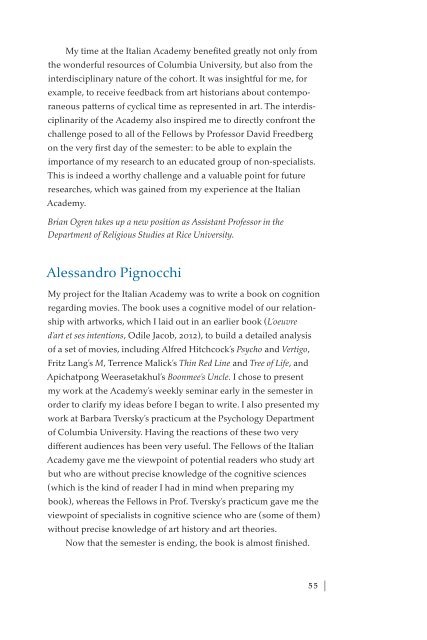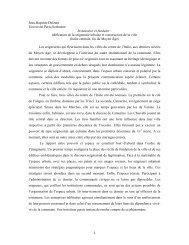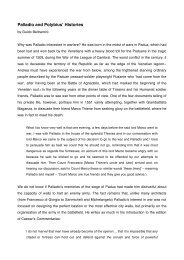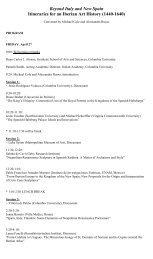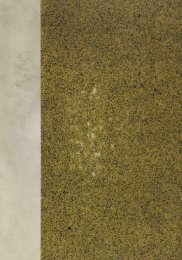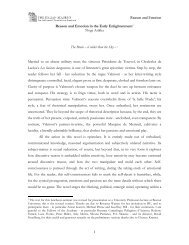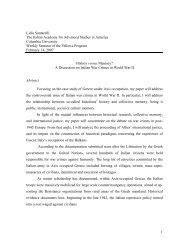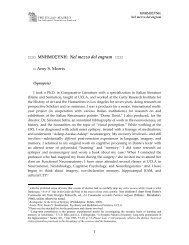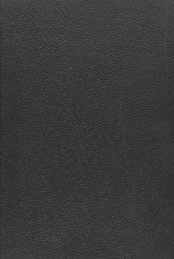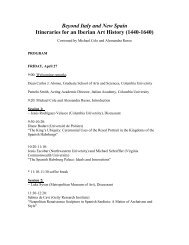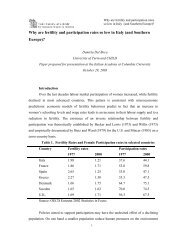2011-2012 - The Italian Academy - Columbia University
2011-2012 - The Italian Academy - Columbia University
2011-2012 - The Italian Academy - Columbia University
You also want an ePaper? Increase the reach of your titles
YUMPU automatically turns print PDFs into web optimized ePapers that Google loves.
My time at the <strong>Italian</strong> <strong>Academy</strong> benefited greatly not only from<br />
the wonderful resources of <strong>Columbia</strong> <strong>University</strong>, but also from the<br />
interdisciplinary nature of the cohort. It was insightful for me, for<br />
example, to receive feedback from art historians about contemporaneous<br />
patterns of cyclical time as represented in art. <strong>The</strong> interdisciplinarity<br />
of the <strong>Academy</strong> also inspired me to directly confront the<br />
challenge posed to all of the Fellows by Professor David Freedberg<br />
on the very first day of the semester: to be able to explain the<br />
importance of my research to an educated group of non-specialists.<br />
This is indeed a worthy challenge and a valuable point for future<br />
researches, which was gained from my experience at the <strong>Italian</strong><br />
<strong>Academy</strong>.<br />
Brian Ogren takes up a new position as Assistant Professor in the<br />
Department of Religious Studies at Rice <strong>University</strong>.<br />
Alessandro Pignocchi<br />
My project for the <strong>Italian</strong> <strong>Academy</strong> was to write a book on cognition<br />
regarding movies. <strong>The</strong> book uses a cognitive model of our relationship<br />
with artworks, which I laid out in an earlier book (L’oeuvre<br />
d’art et ses intentions, Odile Jacob, <strong>2012</strong>), to build a detailed analysis<br />
of a set of movies, including Alfred Hitchcock’s Psycho and Vertigo,<br />
Fritz Lang’s M, Terrence Malick’s Thin Red Line and Tree of Life, and<br />
Apichatpong Weerasetakhul’s Boonmee’s Uncle. I chose to present<br />
my work at the <strong>Academy</strong>’s weekly seminar early in the semester in<br />
order to clarify my ideas before I began to write. I also presented my<br />
work at Barbara Tversky’s practicum at the Psychology Department<br />
of <strong>Columbia</strong> <strong>University</strong>. Having the reactions of these two very<br />
different audiences has been very useful. <strong>The</strong> Fellows of the <strong>Italian</strong><br />
<strong>Academy</strong> gave me the viewpoint of potential readers who study art<br />
but who are without precise knowledge of the cognitive sciences<br />
(which is the kind of reader I had in mind when preparing my<br />
book), whereas the Fellows in Prof. Tversky’s practicum gave me the<br />
viewpoint of specialists in cognitive science who are (some of them)<br />
without precise knowledge of art history and art theories.<br />
Now that the semester is ending, the book is almost finished.<br />
55 |


